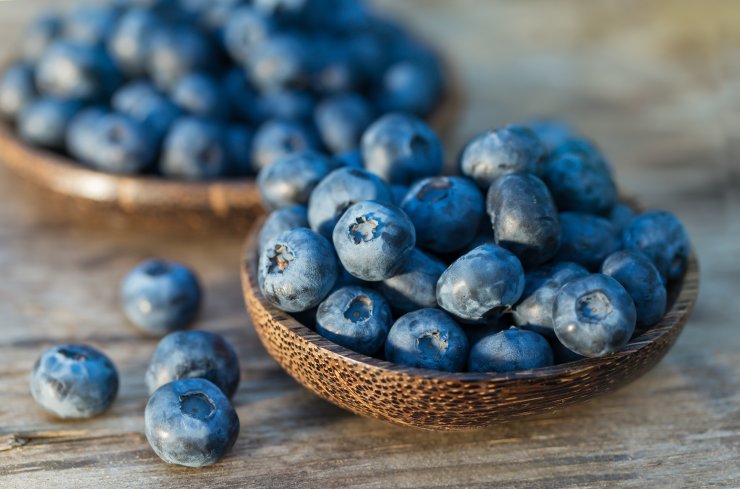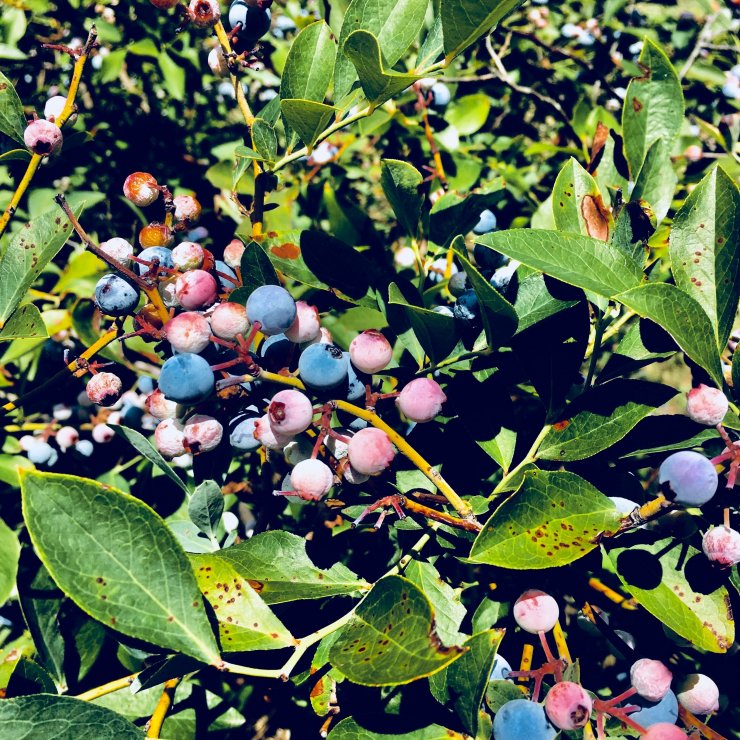
blueberries in a bowl
The tiny blueberry has gained popularity as a superfood: it’s delicious and nutritious, and benefits our bodies inside and out. And it’s been around for thousands of years. Scientists think blueberries were one of the first edible berries early man found after the last ice age. Native Americans have long understood the benefits of blueberries; historians say Native Americans shared blueberries with the Pilgrims to help them make it through their first winter on the new continent.
The best blueberries are the ones you can pick fresh off the bush itself. Blueberry farms with pick-your-own days make for a great family outing—and a delicious haul of versatile fruit. Jam, muffins, bread, crumbles, ice cream—blueberries offer a wide range of possibilities!
Over the years, botanists cultivated blueberries to get a plant that would produce a high yield with low maintenance. Enter the highbush blueberry—this is likely what you see when you pick up blueberries at the market. Blueberry bushes are all over the United States. In fact, 38 states grow blueberries commercially—but just 10 states make up more than 98% of all U.S. production: California, Florida, Georgia, Indiana, Michigan, Mississippi, New Jersey, North Carolina, Oregon, and Washington.
Canada grows highbush blueberries in the west, in British Columbia. Chile, Argentina, Peru, and Uruguay produce the bulk of blueberries in South America. With the continents’ opposite seasons, this means blueberries are almost always in season somewhere!
More than half of all highbush blueberries go straight to market as fresh berries. The rest wind up in yogurt, pastry, muffins, trail mix, and more. Whether you get them fresh, frozen, pureed, concentrated, canned, or dried, you’ll always be able to find a use for the small and mighty blueberry.
A Brief History of Blueberries

Ripening blueberries on bush
Blueberries are one of only three berries native to North America; the other two are cranberries and Concord grapes. Blueberries have been on the continent since the end of the last ice age, providing sustenance to people and animals for thousands of years.
North America’s indigenous people ate the berries fresh, dried them to get them through long winters, and steeped the roots to make healing tea. Native Americans called blueberries the star berry for the five-pointed star shape left on the berry after the flower has bloomed. They believed the Great Spirit sent the star berry to ease the hunger of children when tribes experienced famine.
Serious efforts to cultivate the blueberry didn’t really begin until the early 20th century; until then, people didn’t think the blueberry could be domesticated. But a determined woman in New Jersey would prove them wrong.
It wasn’t until 1916 that blueberries started their trip from farm to table—but first we need to go back to 1893. Joseph J. White was a nationally recognized leader in the cranberry market; some even called the New Jersey grower the Cranberry King. White was a man of many talents; beyond blueberry farming, he was a skilled machinist and an inventor with several patents. As a successful cranberry grower, he published Cranberry Culture—a guide for growers—in 1869.
It was that same year that White married Mary Fenwick, whose father, James Fenwick, was an accomplished cranberry grower in his own right. And so, the cranberry dynasties joined together. Joseph and Mary White’s daughter, Elizabeth, became the trusty sidekick, confidante, and farming partner.
As a child, Elizabeth spent a lot of time working in the cranberry bogs with her father. She learned how to assess the developing crop and spot insect or disease hazards. When she was just 22, Elizabeth discovered that she had a real knack for agricultural research, and started experimenting with ways to eradicate the pesky cranberry katydid. She enlisted the help of New Jersey state entomologist J.B. Smith. Together, they discovered the solution to katydid infestation: burn the grasses on which the katydids lay their eggs. Later in her life, Elizabeth said it was this success that boosted her confidence. Without that experience, she might not have pursued the idea of cultivating the blueberry—and we might never have had blueberries as we know them!
Elizabeth and her father had discussed the possibilities of growing blueberries as a second crop; cranberries don’t ripen until the fall, but blueberries ripen in the summer. There were plenty of wild blueberries by the bogs and in the surrounding woods, but blueberries seemed resistant to taming. However, Elizabeth had been bitten by the farming bug; those wild blueberries would be no match for her!
Meanwhile, in 1908, USDA botanist Frederick Coville was on a quest to find the best blueberry plants for cultivation. After much research and testing, Coville discovered a particular quirk of the blueberry: it only likes acidic soil.
Coville wrote up the results of his research in 1910. And who do you think read that research? Yup—Elizabeth White. She contacted Coville and invited him to use the family farm in Whitesbog, New Jersey as a test site. She even offered to help with the experiments. The pair collaborated to cultivate the most productive wild plants for developing a reliable domestic plant. In 1912, they had their first successful field of blueberry plants. The domestic blueberry was on its way.
Now, Coville was no farmer and Elizabeth was no scientist, but she knew the area, and she knew the local berry pickers. She enlisted their help to find the best wild blueberry bushes. She named the bushes for their finders—Haines, Harding, Grover. The best bush was discovered by a man named Rube Leek. Coville and White didn’t think either the first name or last name was appropriate for a blueberry plant, so they named it Rubel. You can still get Rubel bushes today.
Much of the development work was split between White in New Jersey and Coville in Washington, D.C. White would gather root cuttings of the most promising bushes and send the best of them to Coville—where he would hybridize them in government greenhouses.
Fast forward a few years. In 1916, White and Coville harvested and sold their first commercial crop of domesticated highbush blueberries. It didn’t take long for the sweet, juicy berries to cause a commotion. In 1917, Whitesbog blueberries hit the market, sparking “blueberry fever” throughout the region. Blueberries had found a firm foothold in the fruit market.
Blueberries continued to be popular, and Elizabeth White kept working at her family farm, trying different approaches to make her blueberries even better. It took a while—15 years, in fact—but in 1932, the state of New Jersey finally recognized White for her “outstanding contributions to agriculture.”
As time went on, blueberry bush seedlings started making their way to other states as farmers planted test patches of their own. From 1942 to 1962, hundreds of thousands of blueberry plant seedlings spread across 13 states. The domesticated blueberry industry was growing. In 2003, New Jersey declared the blueberry as its state berry. By 2012, you could find blueberries in thousands of products, including pet foods and cosmetics.
You can still see where the whole blueberry craze began in historic Whitesbog Village in New Jersey. It’s a state and national historic site now. You can tour the village and its cranberry bogs and blueberry fields year-round.
Did you know that New Jersey is such a big blueberry state? And that Maine isn’t even in the top ten blueberry-producing states? Do you know any cool facts about blueberries? Please tell us what you know by commenting below.


 Previous
Previous

